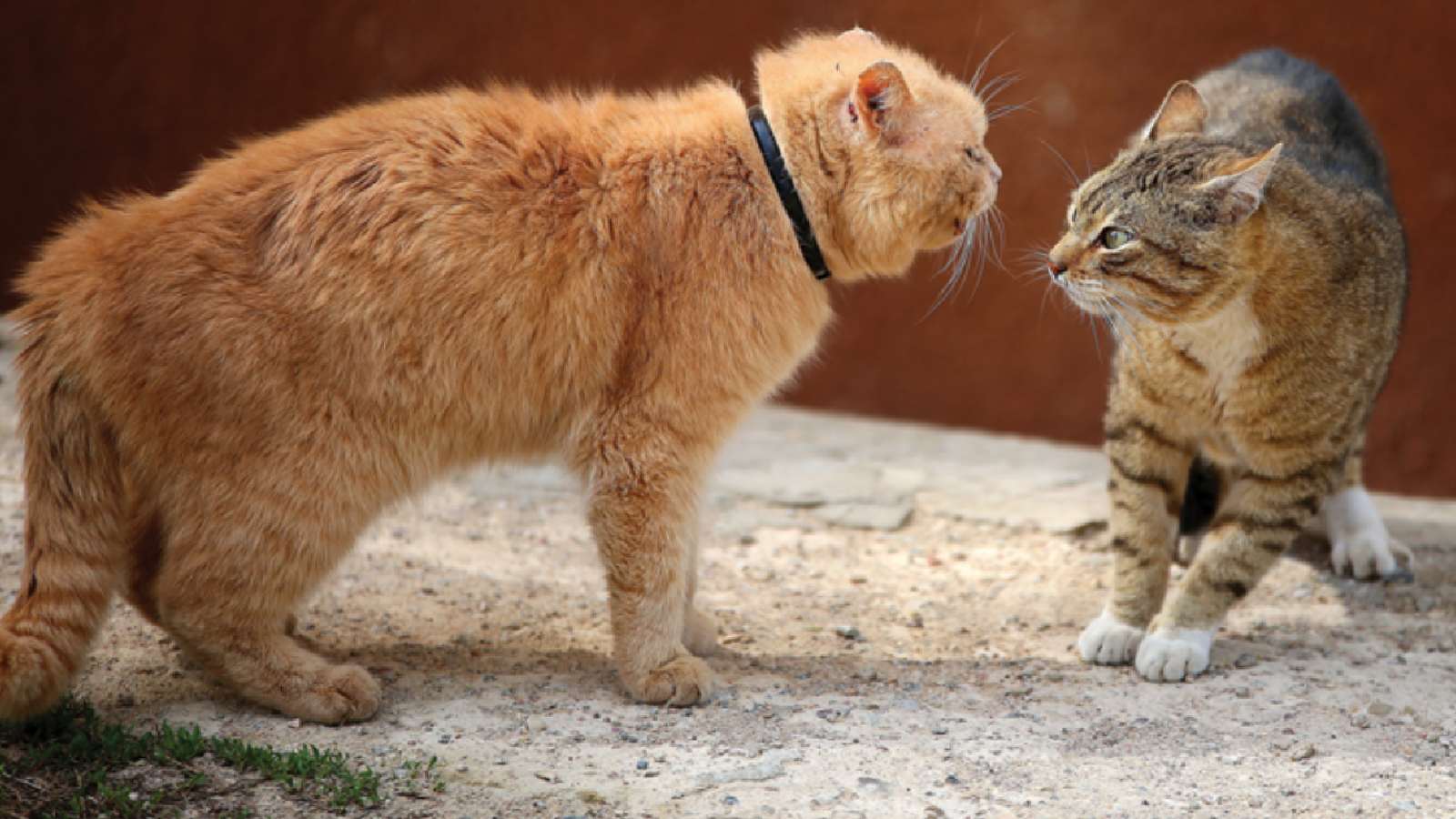
<p>
Living with multiple cats should be a peaceful, enriching experience. However, some cat owners find themselves witnessing frequent hostility between their pets. If your home has turned into a feline battleground, you’re not alone. Inter-cat aggression is a common behavioral issue that can arise for a variety of reasons, from social anxiety and territorial disputes to mismatched personalities and environmental stressors.
</p>
<p>
Cats, by nature, are complex and highly sensitive to changes in their environment. Unlike dogs, they did not evolve to live in packs, and their social structures are subtle and fluid. When two or more cats are forced to share a living space without the right introduction, stimulation, and ongoing support, tension can build up rapidly. This article offers a deep dive into understanding the root causes of aggression between household cats and provides practical, science-backed methods for reducing and ultimately <strong>solving household cat aggression</strong>.
</p>
<p>
You might be wondering why cats who once coexisted peacefully suddenly turn hostile. Or perhaps you’re introducing a new cat to your long-time feline companion and facing immediate resistance. In either case, understanding feline behavior is crucial to creating a calm and safe home for all your pets. From biological triggers and social development to miscommunication and stress responses, feline aggression is multifactorial—and with the right approach, manageable.
</p>
<p>
In the following sections, we will explore common causes of feline aggression, identify early warning signs, and offer structured solutions tailored to both mild and severe cases. Whether you’re dealing with occasional hissing or daily brawls, this guide will help you build harmony between your cats—and restore peace in your home.
</p>
<h2>Why Some Cats Just Don’t Get Along</h2>
<p>
While we often think of cats as independent and low-maintenance pets, their social dynamics can be surprisingly complex. Not all cats are naturally inclined to accept other felines, especially when they’ve had limited social experiences in their early lives. This condition, known as <strong>undersocialization</strong>, is a common root of household cat aggression. A cat that grows up as a solitary pet may lack the social cues and behaviors needed to interact peacefully with others.
</p>
<p>
When introduced to a new feline companion, an undersocialized cat may feel anxious, threatened, or simply irritated by the presence of another cat invading what they consider their territory. Cats thrive on predictability, and a sudden change—like the arrival of a new pet—can disrupt their routine and trigger defensive behavior. This disruption is particularly problematic in established environments where one cat sees the entire home as its domain.
</p>
<h3>Territoriality and Personality Clashes</h3>
<p>
Cats are naturally territorial animals. While some may tolerate overlapping territories, others prefer distinct personal space. Conflicts are especially likely when two unrelated males or two unrelated females are housed together. The lack of choice in selecting their companions can lead to personality mismatches, which manifest as aggression or avoidance.
</p>
<p>
Even cats that initially got along may experience changes in their relationship over time. One cat reaching social maturity—usually between the ages of one and three—can shift the dynamic dramatically. Sometimes, aggression surfaces after a negative experience, such as loud fireworks or a stressful vet visit, becomes associated with the other cat.
</p>
<p>
In all these cases, solving household cat aggression requires patience, understanding, and behavioral strategies that respect each cat’s boundaries and social preferences.
</p>
<h3>When to Consider a Medical Cause</h3>
<p>
Any sudden or uncharacteristic aggressive behavior may indicate an underlying medical condition. If your cat begins to act out without a clear external trigger, it’s essential to consult your veterinarian. Pain, hormonal imbalances, or neurological issues can sometimes present as aggression. Early medical intervention can help rule out physical causes before attempting behavioral modification strategies.
</p>
<h2>Other Types of Feline Aggression</h2>
<p>
While territorial and social mismatches are among the most common causes of feline conflict, other forms of aggression can emerge depending on age, hormonal state, and behavioral context. Understanding the type of aggression you’re dealing with is critical for <strong>solving household cat aggression</strong> effectively.
</p>
8 Types of Cat Aggression Explained! – YouTube
<h3>Maternal Aggression</h3>
<p>
A mother cat protecting her kittens may exhibit strong defensive behaviors—even toward cats she previously tolerated or bonded with. This is known as <em>maternal aggression</em>. Hissing, growling, chasing, swatting, and biting are all typical. Such behavior is instinctual and usually temporary, fading as the kittens are weaned. However, it can be intense and unpredictable while it lasts.
</p>
<p>
To prevent recurrence of maternal aggression, it’s strongly recommended to spay female cats. Not only does this help control the pet population, but it also reduces hormone-driven behavioral problems.
</p>
<h3>Play Aggression</h3>
<p>
Young cats and kittens often engage in rough play that mimics real hunting or fighting. Stalking, pouncing, chasing, swatting, and light biting are all normal components of feline play. The key difference between play and true aggression lies in the context and reciprocity. Play is mutual—cats take turns, their body language remains relaxed, ears are forward, and although claws may be visible, they usually don’t cause injury.
</p>
<p>
Misinterpreting play as aggression can lead to unnecessary intervention or punishment, which may confuse or frustrate the cats. It’s important to observe their cues carefully. If the activity remains balanced and both cats willingly re-engage, it’s likely just harmless play.
</p>
<h2>Suggestions for Managing Aggressive Cats</h2>
<ul>
<li><strong>Do not allow cats to “fight it out.”</strong> Feline disputes rarely resolve through direct confrontation. Allowing fights can worsen the aggression and damage the relationship long-term.</li>
<li><strong>Neuter or spay your cats.</strong> Intact males are significantly more prone to territorial and dominance-based aggression. Neutering reduces hormonal aggression and helps prevent future disputes.</li>
<li><strong>Separate key resources.</strong> Provide each cat with its own food bowl, litter box, water source, and sleeping area—ideally in different rooms—to reduce competition and tension.</li>
<li><strong>Offer vertical space and hiding spots.</strong> Cats feel safer and more in control when they can perch or retreat as needed. Cat trees, shelves, and boxes are valuable tools for stress relief and territorial separation.</li>
<li><strong>Avoid physical intervention.</strong> Never attempt to pick up or calm an aggressive cat during an outburst—it can redirect aggression toward you. Instead, give them space and allow them to calm down on their own.</li>
<li><strong>Reward peaceful behavior.</strong> Reinforce calm interactions by tossing treats or using positive reinforcement when the cats behave appropriately near each other.</li>
<li><strong>Try pheromone diffusers.</strong> Products like Feliway emit synthetic feline facial pheromones that promote calm and can be effective during reintroductions or transitional periods.</li>
</ul>
<h2>Reintroducing Cats After Aggression</h2>
<p>
When aggression occurs between cats that once got along—or between cats struggling to accept one another from the start—it’s essential to manage the reintroduction process carefully. Whether the aggression is mild or severe, structured reintroduction can dramatically improve outcomes and assist in <strong>solving household cat aggression</strong>.
</p>
<h3>If the Aggression Is Mild or Between Previously Friendly Cats</h3>
<p>
For mild conflicts, begin by separating the cats into different rooms for several days or even weeks. Ensure that each cat has access to its own resources, including food, water, a litter box, and bedding. During this period, the cats can hear and smell one another without direct interaction.
</p>
<p>
To rebuild positive associations, feed the cats on opposite sides of a closed door. Over time, this reinforces a connection between the other cat’s scent and a positive experience (eating). You can also switch the cats between rooms daily, allowing each to explore the other’s scent and space safely.
</p>
<p>
When both cats appear relaxed—no growling, hissing, or swatting—begin to gradually open the door in small increments. If the cats remain calm, increase the exposure over time. If signs of aggression return, close the door and repeat the earlier steps. Patience is key.
</p>
<h4>Tip: Use Scent to Your Advantage</h4>
<p>
Some cat owners have reported success with scent distraction. Rubbing a bit of tuna juice on the cats’ heads and backs encourages grooming—a calming activity. In some cases, this even leads to mutual grooming, which strengthens bonds between cats.
</p>
<h3>If the Aggression Is Severe or Between Cats Who’ve Never Gotten Along</h3>
<p>
In cases of severe or prolonged aggression, a much slower, controlled reintroduction process is needed. Keep the cats separated for an extended period and implement daily, supervised reintroduction sessions. Use treats, toys, or food to maintain their focus and build positive associations.
</p>
<table border=”1″ cellpadding=”8″ cellspacing=”0″>
<caption><strong>Steps for Reintroducing Aggressive Cats</strong></caption>
<thead>
<tr>
<th>Stage</th>
<th>Action</th>
<th>Goal</th>
</tr>
</thead>
<tbody>
<tr>
<td>Phase 1</td>
<td>Complete separation with scent swapping and feeding near closed door</td>
<td>Build positive scent association</td>
</tr>
<tr>
<td>Phase 2</td>
<td>Short, supervised visual contact (e.g., cracked door, baby gate)</td>
<td>Reduce visual triggers</td>
</tr>
<tr>
<td>Phase 3</td>
<td>Supervised time together with distraction (treats, play)</td>
<td>Promote positive interaction</td>
</tr>
<tr>
<td>Phase 4</td>
<td>Gradual increase of time together</td>
<td>Restore trust and comfort</td>
</tr>
</tbody>
</table>
<p>
Using harnesses and leashes or placing one or both cats in crates can provide additional control during reintroduction sessions. The key is to avoid escalation and to separate the cats again between each session. Never force interaction—each step should feel safe and predictable.
</p>
<p>
Once both cats can eat and play near each other without signs of stress or aggression, you may begin allowing short, unsupervised interactions. Always increase duration gradually.
</p>
<h4>Consider Behavioral Medication</h4>
<p>
For particularly stubborn or anxious cases, consult your veterinarian about temporary behavioral medication. These can help reduce a dominant cat’s assertiveness or calm a fearful one, easing the transition and improving the chance of success.
</p>
<h2>When to Seek Professional Help</h2>
<p>
If your efforts at reintroduction or behavior modification have failed, or if the aggression seems to escalate despite all strategies, it may be time to consult a qualified animal behavior expert. A <strong>Certified Applied Animal Behaviorist (CAAB or ACAAB)</strong> or a <strong>board-certified veterinary behaviorist (Dip ACVB)</strong> can evaluate your home setup, your cats’ personalities, and the underlying causes of the aggression. These professionals use evidence-based methods and personalized interventions that go beyond general advice.
</p>
<p>
You can usually find a qualified behaviorist through referrals from your veterinarian or via reputable directories such as the <a href=”https://animalbehaviorsociety.org” target=”_blank” rel=”noopener”>Animal Behavior Society</a> or the <a href=”https://www.dacvb.org/” target=”_blank” rel=”noopener”>American College of Veterinary Behaviorists</a>.
</p>
<h3>When Rehoming May Be the Kinder Option</h3>
<p>
As difficult as it may be to consider, some cats simply cannot coexist peacefully—despite all best efforts. Chronic tension, stress, and fear can take a toll on both animals and humans. If multiple reintroduction attempts have failed, if fights are causing injuries, or if one or both cats are living in constant fear, you may need to consider long-term separation or rehoming one of the cats to a suitable environment.
</p>
<p>
This decision should never be made lightly, but it is not a failure. It can be the most compassionate choice for all involved, allowing each cat to live in a calm and safe space suited to its temperament. Even lifelong cat lovers and experts sometimes face these difficult scenarios, and prioritizing well-being is always the right choice.
</p>
<h2>Final Thoughts: Rebuilding Peace at Home</h2>
<p>
Feline aggression can be deeply distressing, especially when it disrupts the harmony of your household. But with patience, understanding, and the right strategies, it’s possible to restore balance. Whether the conflict stems from poor socialization, territorial disputes, or fear-based behaviors, your role as a cat guardian is to interpret their signals, protect their space, and implement gradual, non-threatening interventions.
</p>
<p>
Remember that each cat is an individual. What works for one may not work for another. But by recognizing patterns, seeking professional guidance when needed, and consistently applying gentle management techniques, you’ll be one step closer to <strong>solving household cat aggression</strong>—and bringing peace back to your home.
</p>




